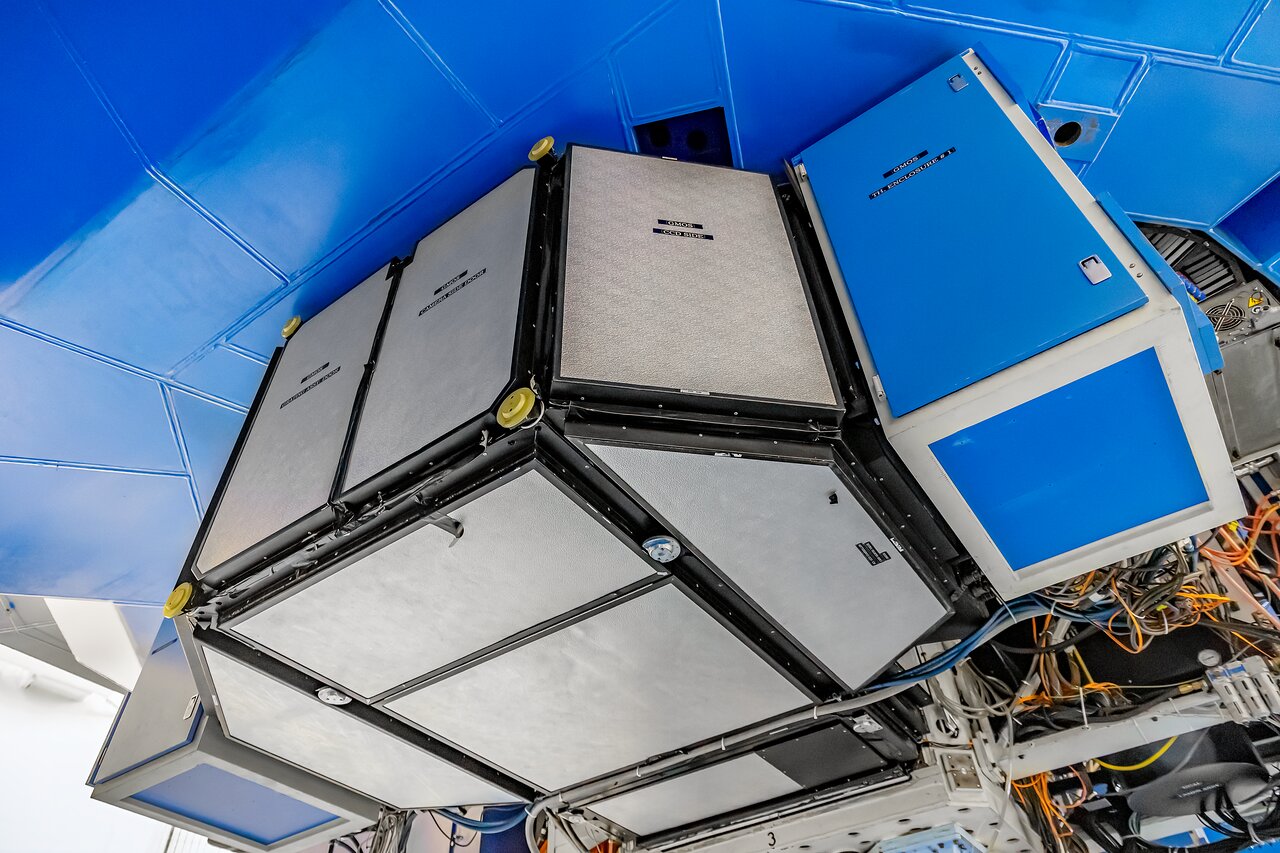Gemini Multi-Object Spectrograph (GMOS)
The back end of the Gemini North telescope, tilted down, showing the suite of scientific instruments mounted on the Instrument Support Structure (ISS). GMOS is on the right-hand port.
The GMOS instruments include GMOS-N at the Gemini North telescope on Maunakea in Hawai‘i and GMOS-S at Gemini South on Cerro Pachón in Chile. Their construction was a collaboration between the Astronomy Technology Centre at the Royal Observatory Edinburgh and the University of Durham in the UK, and the Herzberg Institute of Astrophysics in Canada. They are the International Gemini Observatory’s twin workhorse instruments for observations at visible wavelengths. They can be used as either a spectrograph or an imager. While there are slight differences, the information here applies to both instruments.
GMOS instruments detect light in the 0.36–1.03 micrometer wavelength range and operate in four modes: three spectroscopic modes — long slit mode, multi-object mode, which captures spectra from many objects simultaneously, integral field spectroscopy mode, which collects spectra from a two-dimensional area of the sky — and an imaging mode. This versatility allows for a wide range of astronomical observations.
The mechanical system is designed to minimize tilts between optical components so that the only effect of flexure is a slow motion of the detector perpendicular to the optical path. This allows the detector to simply be repositioned to compensate for any warping of the instrument due to gravity in real time, keeping the images as sharp as possible.
More on GMOS.
The Gemini Multi-Object Spectrograph (GMOS) mounted on Gemini South on Cerro Pachón in Chile.
Credit: CTIO/NOIRLab/NSF/AURA/D. Munizaga
Science Highlights of GMOS-N
- Gemini North Spies Ultra-Faint Fossil Galaxy Discovered on Outskirts of Andromeda
- Astronomers Uncover Briefest Supernova-Powered Gamma-Ray Burst
- Black Hole Pairs Found in Distant Merging Galaxies
Science Highlights of GMOS-S
Quick Facts
|
|
Gemini Multi-Object Spectrograph The technical information for astronomical observations is available at the NOIRLab Gemini Observatory webpage. |
|
|
Site |
GMOS-N: Maunakea, Hawai‘i GMOS-S: Cerro Pachón, Chile |
|
Telescopes |
International Gemini Observatory North/South |
|
Type |
Spectrograph/Imager |
|
Wavelength range |
360−1030 nm |
|
Spatial sampling |
0.0807 arcsec per pixel |
|
Detector format |
one science detector composed of three 2048 x 4176-pixel CCDs in a row with two small gaps |
|
Detector total size |
GMOS-N: 6278 x 4176 pixels (mosaiced — after tiling) GMOS-S: 6266 x 4176 pixels (mosaiced) |
|
Spectral resolution |
R up to 10,000 with 0.25-arcsec slits |
|
Field of view |
Slit mode: 5.5 x 5.5 arcmin IFS mode: 35 x 35 arcsec |
|
Filters |
|
|
Gratings |
|
|
Date of first light |
GMOS-N: 2002 GMOS-S: 2003 |
|
Science goals |
Multi-purpose instrument for scientific observations in the visible range. |
|
Images taken with the instruments |
|
|
Images of the instrument |
|
|
Press releases with the instrument |
|

